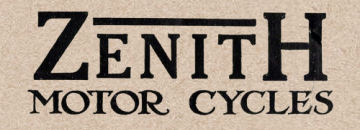


Zenith motorcycles were produced from 1905 to 1950 at Hampton Court, Surrey.
1905 A strange machine appeared, called the Bicar, that was said to be 'a revolution in motorcycles'. It was first seen early in the year, at the Crystal Palace show, named the Tooley Bi-Car after its inventor and exhibited by Bitton and Harley of Great Yarmouth. By July, it had been improved and renamed the Zenith. It had a novel frame, with the main tube running from the rear wheel spindle along the machine, round the front wheel and back again. Under this, on each side, ran a second tube to carry the weight of the rider and the engine, which was hung from joints to eliminate vibration. It had hub centre steering, so there were no front forks as such - the handlebars were connected to the wheel axle by stays. The engine was a 3hp Fafnir with a free-engine clutch and belt drive to the rear wheel, which had a drum brake. They also offered the Tricar with a 5hp engine and two speeds, both of which were soon options for the Bicar.
The Zenith bicar is a conspicuous-looking machine of novel construction. It is fitted with a 3h.p. air-cooled engine with free clutch. Comfortable footboards are provided, and by the special arrangement of the design of the frame it is claimed that vibration is eliminated.
26in. wheels are fitted, and a low saddle position, so that it is possible for the rider to touch the ground with his feet while sitting in the saddle. The handle-bars are brought well back, so that the most comfortable riding position is adopted by sitting upright. Other specialities are a tricar, driven by a 5 h.p. twin-cylinder air-cooled engine with two-speed gear
1907 Motorcycle production began with the sprung-frame Zenette and its 3.5hp Fafnir engine. The firm was run by Freddie W. Barnes who patented his own Gradua Gear system, which combined a variable engine pulley with movement of the rear wheel to maintain the correct belt tension. It used a system of rods connected to a single handle, so the gear could be altered while on the move. This was very useful in hill climbs as the Zenith rider could change gear on the upward journey, while the other competitors had to make do with a single choice of gear ratio. Because of this, some clubs banned the Zenith from their events, but Zenith was quick to recognize the publicity value and took the word 'barred' as their trademark.
1908 Late in the year the Zenette was joined by a rigid model of lower weight that had sprung forks and improved hill-climbing ability. At the end of the year, the firm moved to Church Street, Weybridge, Surrey, close to Brooklands.
1909 At Brooklands, Barnes set the first record Test Hill early in the year. All machines were now sold as Zeniths and the firm became much more successful.
1910 The Gradua Gear mechanism was improved and tidied up, as was the whole machine, which looked typical of the era and had Druid forks. The Zenette continued to be offered for that year.
Zenith Motors, Ltd.
Weybridge. Stand No. 70.
There will be a comprehensive exhibit on this stand including the 3½ H.P. Zenith Gradua, the 3½ H.P. Zenith with side car, the 6 H.P. Zenith Gradua, and the Triumph Gradua. There will be a demonstrating model of Gradua gear. All the machines are fitted with J.A.P. engines, Brown and Barlow carburetter, Druid forks, and special Zenith stand. Amongst the improvements will be special parallel brake movement, and a new pattern silencer and cut out.
1910 Stanley Show Report
Cycle and Motor Trades Review
1912 During the year there were many detail improvements.
1913 The range added three racing models with JAP ohv engines, 2¾ hp and 3½ hp singles and an 8hp V-twin, plus a road model with a 4hp water-cooled Green engine.
1914 The models were much revised, with a chain-driven countershaft, complete with clutch and kick-starter, mounted in front of the crankcase. The countershaft carried a large pulley to drive the rear wheel by a long belt, while retaining the Gradua Gear and rear wheel movement. The engines still came from JAP, but all were twins of 3.5hp, 6hp or 8hp. During the year, the firm moved to Hampton Court, Middlesex and continued with their twins until world War I stopped production. See Zenith 1914-1915
1919 Production started again with the 6hp and 8hp models, still with the counter-shaft and Gradua Gear, but, by November, these were joined by a 346cc flat-twin, still with the same transmission.
1921 A model fitted with a 494cc oil-cooled Bradshaw flat-twin engine was introduced and was soon listed with the choice of the Gradua gear or a three-speed Sturmey-Archer gearbox and all-chain drive.
This all-chain drive model should multiply the admirers of the Zenith-Bradshaw.
ZENITH.
The chief item of interest on the Zenith stand will be the chain-driven Bradshaw-engined model, which is a distinct departure from the procedure followed by this firm since its inception being the first all-chain drive type introduced. A detailed description of this machine appears elsewhere in this issue.
Four examples of this new model will be shown, and four Bradshaw-engined Zeniths, which will be belt-driven and with the Gradua gear. These exhibits will demonstrate the cleanness of design of the Bradshaw oil-cooled engine, a road test of which was described in The Motor Cycle of November 10th. There will also be a 5 h.p. J.A.P.-engined sports model, a 5 h.p. J.A.P.-engined machinine with clutch, and an 8 h.p. sidecar outfiit with counter-shaft drive and clutch. The requirements of all classes of riders have been studied, and the machines range from the fastest and most powerful twin cylinder to the mediumweight sports models while the family man's requirements have not been overlooked, the sidecar outfit being a thoroughly well-designed and practical mount.
The Motor Cycle, November 24th 1921
The finest "save" I ever witnessed was achieved by a sporting parson in a provincial event. The hill
was easy, and the cleric was riding a big twin-cylinder Zenith. He streaked over the crest at a mile a
minute, and then steered into a rut. His machine went over, and as he was flung clear, he curled his
body up into a ball, with his head tucked well into his stomach. He bowled along the road for yards
like a tennis ball, but took all the shock on his shoulders and sit-upon, so that he was not a penny
the worse.
From Reminiscences of Motor Cycling, by Ixion.
1922 Most models had the Bradshaw option.
1923 Several singles were introduced, all of conventional form. There was also a special built for an enthusiast, fitted with a Barr and Stroud V-twin sleeve-valve engine.
1924 The Gradua Gear had run its course, so the company offered all chain drive on a range of singles and V-twins that increased annually. All were typical of the decade. One used an ohv single-cylinder Bradshaw engine.
1926 By now there were machines with 348cc Blackburne, 490cc JAP singles and 680cc and 980cc V-twin JAP engines.
1927 A 175cc sv lightweight was added for that year only.
1928 The lightweight was replaced by one using a 172cc Villiers two-stroke engine. The firm still had a sporting interest, and that year O. M. Baldwin set the motorcycle world speed record at over 124mph.
1930 Joe Wright used a Zenith to take the record to over 150mph (240km/h). Unfortunately, these sporting successes did not sell many machines, and the firm was taken over by Writer's, a large south London dealer.
1931 A reduced range was listed, all with JAP engines.
1933 Twenty models were offered.
1934 The range had reduced to fourteen models.
Zenith at the 1935 Olympia Show
1939 The range had dwindled to just six models, which were all somewhat old-fashioned.
Post-war. They returned in 1947, but only one model was ever listed, and this used the 747cc sv JAP V-twin, in the pre-war format, with Druid girder forks. In time these were changed to Dowty Oleomatic.
1950 Production ceased.
Source: Graces Guide